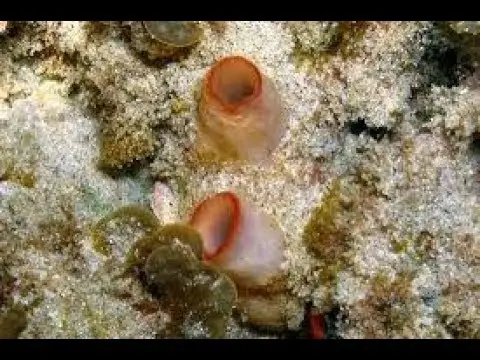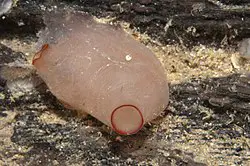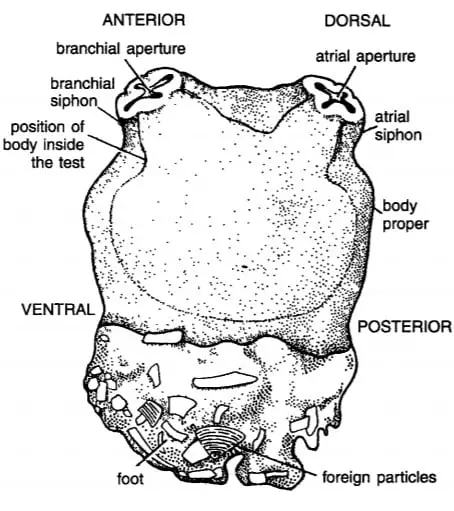In Herdmania the visceral organs are protected through different layers, on the outer side the body of Herdmania is covered by a tunic or test, below the tunic mantle is present, the mantle secret the tunic layer.
Table of Contents
Mantle:
The mantle is a living covering of the visceral organs in Herdmania which present just below the test or tunic. The mantle performs the functions of the body wall in Herdmania, it is attached to the tunic at the branchial aperture and atrial aperture, the mantle covering varies in thickness in a different portion of the body.
Mantle covering is much thicker in the anterior-dorsal region due to highly musculature and opaque but in the posterio-ventral side, it has less musculature and is so transparent that most of the visceral organs are visible.

The mantle or body wall has three distinct layers, from outside to inside the are outer epidermis, middle mesenchyme layer, and innermost inner epidermis.
Outer Epidermis:
The outermost cellular layer of the mantle is made of a single layer of flat, hexagonal-shaped cells and this cellular layer is responsible for secreting the tunic layer. The outer epidermal cells present up to the base of the siphon of branchial and atrial aperture and form stomodaeum and proctodaeum.
Mesenchyme:
Below the outer epidermis, the mesenchyme layer is present which is developed from the mesoderm, in this layered network of connective tissue fibers, nerve fibers, muscles fibers, and blood sinuses present.
In both siphons, several circular rings of annular muscle are present which enables the two siphons to contract, below the annular muscle, longitudinal muscle fibers are present from the two aperture to the middle of the body which contract body.
In between the branchial siphon and atrial siphon, some muscle fibers are present, in between the connective tissue, amoeboid, and vacuolated cells.

Inner Epidermis:
Inside the mantle covering a cavity present which is known as an atrial cavity, flat and hexagonal cells form the inner epidermis layer which gives the lining of the atrial cavity.
Visceral Organs of Herdmania:
After the removal of the test, through the mantle covering most of the visceral organs are visible from outside, most of the visceral organs present in the posterior-ventral region of the body. We will not discuss the anatomy of the visceral organs here but we will list the visceral organs which are visible from outside of mantle covering ——
- The two siphon of branchial and atrial aperture, their musculature, outer annular muscular rings and inner longitudinal muscular layer.
- Neural glands present between the two siphon of branchial aperture and atrial aperture.
- Right liver lobe, left liver lobe and pericardium, right gonad, left gonad, endostyle, wide loop of intestine, stomach, rectum.
All the visceral organs are not visible from one side, some visceral organs visible from the left side while some visceral organs are visible from the right side. In the foot region, only a tunic is present, no visceral organs are present in foot part, visceral organs are only present in the body proper.
Coelom:
True body cavity or coelom is present in Herdmania but the coelom is not very clear in adult Herdmania. The coelom is reduced due to degeneration, over development of the atrium.
Atrium:
In between the mantle covering and pharynx, a cavity is present which is known as an atrium, the atrium is not present in the anterior-dorsal side due to the fusion of the pharyngeal wall with mantle covering. Part of the atrium in the lateral sides of the pharynx is known as the peribranchial cavity which continues with the pharyngeal cavity through the stigmata present on the pharyngeal wall. Above the pharynx, the atrial cavity becomes much wider which is known as the cloaca, the anus and gonopore open into the cloaca.

The cloaca opens outside through the atrial siphon and atrial aperture, the band of annular muscle present in an atrial siphon, a special serrated structure present on the inner lining inside the cloaca cavity, known as atrial tentacles.
Reference Habitat and Habits of Herdmania
Detailed Information on
Habitat and Habits of Herdmania
Hi Everyone!!! Welcome to Imaluop. Imaluop always try to learn some new and he want to share to other people. Here we will try to learn various topics on Science, specially on Biological Sciences.